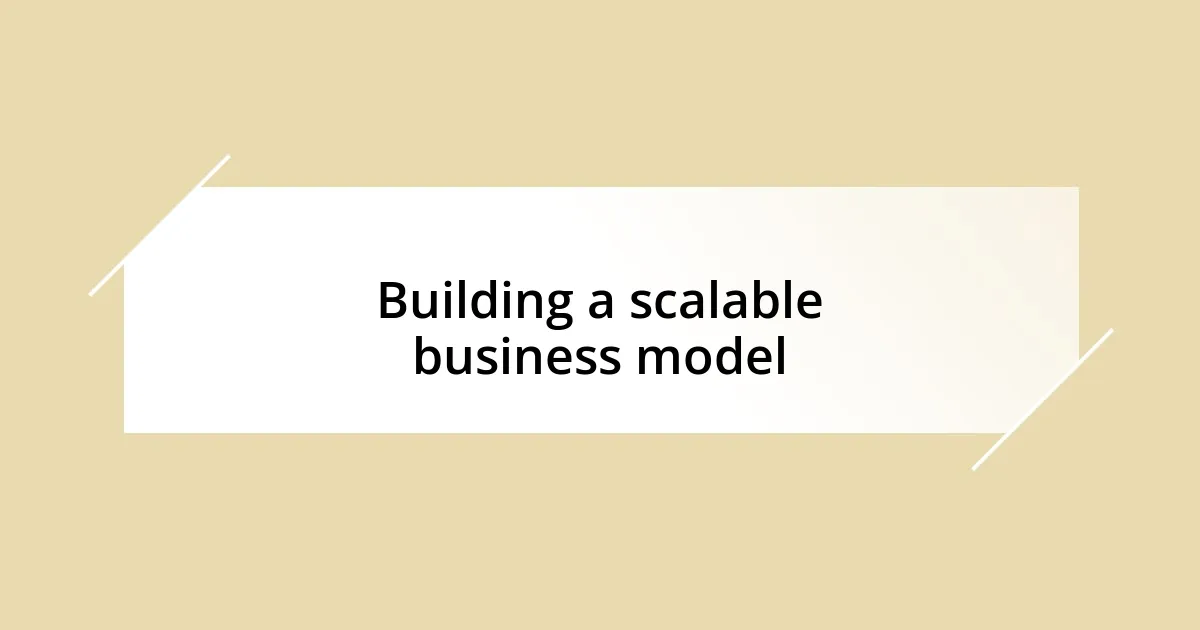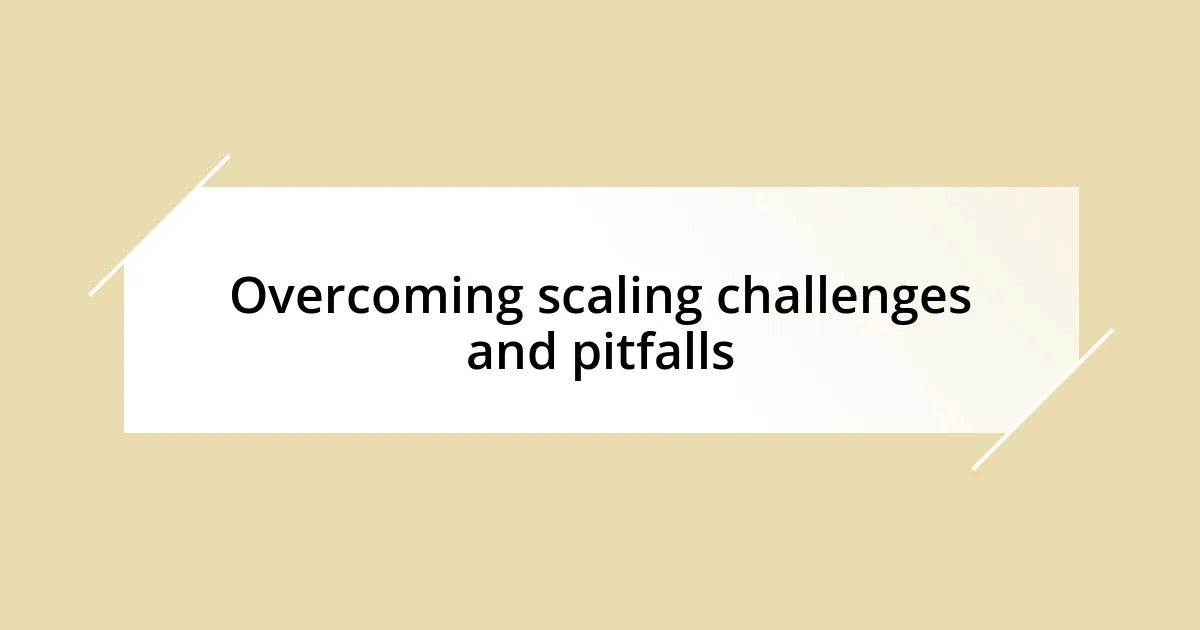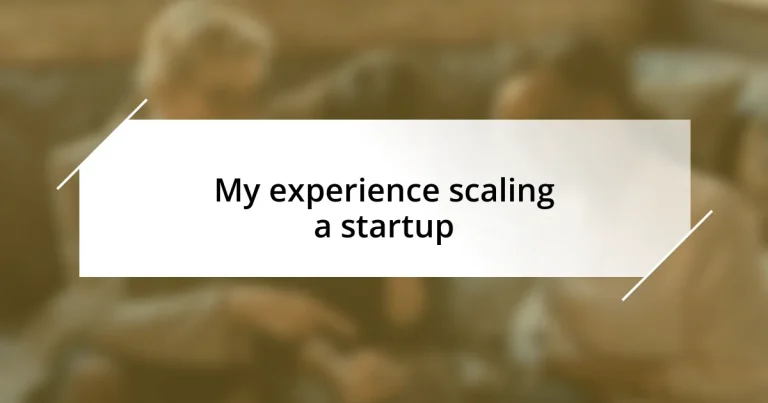Key takeaways:
- Startup scaling involves distinct phases: Validation, Growth, and Maturity, each requiring different strategies for success.
- Identifying key growth metrics like CAC, LTV, and Churn Rate is crucial for tracking progress and driving informed decisions.
- Hiring for culture and diversity enhances team cohesion and stimulates innovative thinking, crucial for sustainable growth.
- Creating a financial buffer and refining pricing strategies aid in managing cash flow and securing funding effectively.

Understanding startup scaling phases
As I navigated the early stages of scaling my startup, I quickly realized that understanding the phases of growth is crucial. In my experience, the first phase, often called “Validation,” involves proving your idea can solve a real problem. I remember questioning whether we had our market fit, wondering if all the late nights were worth it.
Moving into the “Growth” phase, I felt both exhilarated and overwhelmed. Suddenly, we had customers, and demands skyrocketed. It was exciting to witness our vision coming to life, yet I often pondered—how do you keep the momentum without burning out? I discovered that building a reliable team around me was essential; collaboration became the backbone of our success.
Finally, the “Maturity” phase challenged everything I thought I knew about sustainability. I found myself reflecting on how to innovate while maintaining our established processes. It wasn’t just about growth anymore; it was about staying relevant. I often asked myself: How do we adapt without losing our identity? This phase taught me that constant reassessment and a willingness to pivot are the keys to longevity in the startup world.

Identifying key growth metrics
Identifying the right growth metrics was a turning point for my startup. Initially, I struggled to pinpoint what actually mattered. I recall late nights analyzing data, feeling a mix of frustration and excitement, like piecing together a puzzle. As we got clearer on our priorities, I learned how metrics could illuminate our path forward.
To effectively track growth, I focused on a few key metrics that genuinely reflected our progress:
- Customer Acquisition Cost (CAC): Understanding how much it cost to bring in each customer was a game-changer.
- Lifetime Value (LTV): I wanted to know how much revenue we could expect from each customer over time.
- Monthly Recurring Revenue (MRR): This helped me keep a pulse on our income and growth trends each month.
- Churn Rate: It was essential to monitor how many customers we were losing; this was a wake-up call that guided many improvements.
- Net Promoter Score (NPS): Gauging customer satisfaction gave me insights into their loyalty and potential for referrals.
By honing in on these metrics, I could see clear trends forming. I felt a sense of empowerment—data wasn’t just numbers but a narrative unfolding before me. I learned that the right metrics could spark innovative changes, often leading us to pivot in unexpected but rewarding directions.

Building a scalable business model
Building a scalable business model requires a layered approach. During my journey, I discovered that clarity of value proposition was paramount. When we defined precisely how our product addressed customer pain points, it felt like a light bulb moment. I can still recall the day we shared our refined message with the team, and suddenly, everything clicked.
In parallel, investing in technology infrastructure became a critical element for us. Initially, we relied on manual processes, but as we grew, this approach began to suffocate our potential. Implementing automated systems not only streamlined our operations but also freed up my team to focus on creative solutions rather than mundane tasks. I vividly remember the sense of relief the first time we launched an automation tool—it felt like a breath of fresh air.
Lastly, financial sustainability is the backbone of scalably. It’s not enough to have a solid product; you must also ensure profitability from the onset. I recall planning our budget so meticulously that each dollar was mapped to an expected growth outcome. This foresight allowed us to withstand unexpected challenges, building a financial cushion that became our safety net. Every decision I made around finances felt a mix of anxiety and excitement, yet it reinforced the notion that a structured approach could indeed lead to a thriving enterprise.
| Business Model Component | Key Focus Area |
|---|---|
| Value Proposition | Customer Pain Points |
| Technology Infrastructure | Automation & Efficiency |
| Financial Sustainability | Profitability & Budgeting |

Hiring for growth and culture
Finding the right people to hire is not just about filling roles; it’s about building a team that embodies your startup’s culture and vision. Reflecting on my own experience, I remember the pivotal moment when we structured our interview process around cultural fit in addition to skills. One candidate stood out not because they had the most impressive resume, but because their values aligned perfectly with our mission. That’s when I realized that hiring for culture can lead to a more cohesive and motivated team, capable of tackling challenges together.
As we began prioritizing culture in our hiring, it prompted me to ask: how do we define our values, and more importantly, how can we communicate them effectively? I learned the importance of clearly articulating our mission and core values. It was powerful to see candidates’ reactions when they understood our vision; their enthusiasm was infectious, which ultimately led to higher retention rates. For instance, one of our hires became a passionate advocate for our environmental initiatives. This enthusiasm not only boosted morale but also inspired others to engage deeply with our mission.
In scaling my startup, I also discovered the role of diversity in enriching our company culture. I vividly recall the initial hesitations I had about introducing a more diverse hiring strategy; I wondered if it would complicate our processes. However, once we embraced diverse perspectives, our creativity soared. This shift allowed us to innovate in ways I hadn’t imagined. I now believe that achieving growth isn’t just about filling positions but about cultivating a culture that values inclusivity and collaboration, which naturally fuels success.

Leveraging technology for efficiency
Leveraging technology was a game-changer for us. When we transitioned from outdated tools to cloud-based platforms, the shift was instantaneous and profound. I remember one particular instance when we implemented a project management tool; suddenly, everyone was on the same page, and even the simplest tasks became effortless.
Every startup faces inefficiencies, and I can assure you that technology can help pinpoint and eliminate these roadblocks. For us, data analytics became invaluable. It was through understanding our user metrics that I realized how to tailor our offerings better. The thrill of seeing our customer engagement graph spike after making a small technological tweak was genuinely rewarding.
I often ask my peers: what would you do without your tech stack? In my experience, investing in the right software not only enhances team productivity but also fosters innovation. For instance, we adopted AI-driven customer support, allowing us to respond to inquiries faster. The improvement in customer satisfaction levels was palpable, and it inspired me to keep pushing the boundaries of what’s possible with technology.

Managing cash flow and funding
Managing cash flow and funding was like threading a needle in the early days of my startup. I vividly remember the panic of facing unexpected expenses while also trying to secure our next funding round. It wasn’t just about having enough in the bank; it was about understanding the cyclical nature of our business. I learned quickly that tracking cash flow meticulously allowed us to navigate tight spots more confidently. Have you ever felt that knot in your stomach when cash flow dips? I certainly have.
The turning point came when I realized that I needed to create a financial buffer. This meant setting aside revenue during good months to prepare for the leaner times. One tactic that worked wonders was revisiting our pricing strategy. When we raised prices on a few of our services, I felt a jolt of anxiety mixed with excitement. Would our customers accept it? They did! This adjustment not only improved our margins but also reinforced the value we provided. With that extra cushion, I had the breathing room to focus on growth rather than merely surviving.
As we scaled, seeking external funding became a crucial part of my strategy. I went through numerous pitch meetings, often feeling like I was on a roller coaster. The rejection letters still sting when I think about them, but each “no” taught me more about refining my pitch to connect emotionally with potential investors. I learned that storytelling, combined with solid financial projections, captivated their interest. Suddenly, I wasn’t just another startup; I was an entrepreneur with a vision worth believing in. Have you found this blend of storytelling and data impactful in your endeavors? It transformed my approach to funding and solidified my drive to continue pushing forward.

Overcoming scaling challenges and pitfalls
To overcome scaling challenges, I had to embrace the idea that not every decision would be perfect. I remember a moment when we launched a feature that we believed would be a hit, only to find it flopped spectacularly. Instead of dwelling on the disappointment, I knew we had to pivot quickly. This experience taught me that agility is essential; the ability to adapt and learn from missteps can significantly shape your growth trajectory. Have you ever faced a setback that turned out to be a blessing in disguise? I certainly have.
As we expanded our team, maintaining company culture became paramount. I distinctly recall our first major hiring surge. At one point, I felt overwhelmed, as if we were losing the very essence of what made us special. To combat this, I initiated regular team-building activities, which not only fostered connections but allowed us to communicate our core values clearly. When I saw colleagues from different departments bonding over casual games, I felt a sense of pride. This reinforced my belief—how do you ensure that your values are carried through as your team grows?
Lastly, I discovered that setting clear, measurable goals was crucial. In the chaos of scaling, it’s easy to lose sight of long-term objectives. I remember our quarterly planning session when we revisited our mission and realigned our metrics. It felt like hitting a reset button. Having concrete targets allowed everyone to understand their contributions to the bigger picture, boosting motivation and accountability. Isn’t it remarkable how clarity can turn confusion into cohesion? It certainly was for us.














